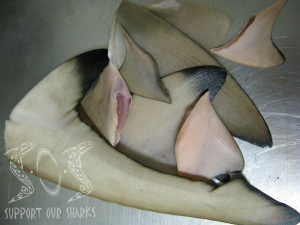And why do we need them?
 What
is a Fin-Ban?
What
is a Fin-Ban?
Fin-bans, referring to the trade in shark fins, make it illegal to buy, sell, or possess shark fins in a given area. In contrast to popular belief, a fin-ban is not a complete ban on shark fishing but instead targets the trade in fins specifically, which still allows for the continued trade in shark meat and other products. In some cases fin bans even allow the continued trade in shark fins for certain species. For example, the Oregon State shark fin ban still allows for the continued legal trade in spiny dogfish fins.
For full details on regions that have
implemented fin-bans
Click Here.
Why Do We Need Fin-Bans?
 Due to overexploitation and lack of proper
shark conservation, many shark species are under considerable risk
of unrecoverable decline with some species having declined to near
extinction in recent years
[1][2]. According to reports,
sharks, rays and skates are being killed at an alarming rate of
up to
273 million per year worldwide [3]. Some experts predict that
if the killing continues at the current rate many species will be
lost forever with potentially devastating implications for our ocean
ecosystems
[4].
In addition, many studies have now revealed that
shark meat and fins contain toxins like mercury [5][6] and BMAA [7] that have been linked with neurodegenerative
diseases in humans. Consumption of such products should therefore be
discouraged.
Due to overexploitation and lack of proper
shark conservation, many shark species are under considerable risk
of unrecoverable decline with some species having declined to near
extinction in recent years
[1][2]. According to reports,
sharks, rays and skates are being killed at an alarming rate of
up to
273 million per year worldwide [3]. Some experts predict that
if the killing continues at the current rate many species will be
lost forever with potentially devastating implications for our ocean
ecosystems
[4].
In addition, many studies have now revealed that
shark meat and fins contain toxins like mercury [5][6] and BMAA [7] that have been linked with neurodegenerative
diseases in humans. Consumption of such products should therefore be
discouraged.
Anti-Finning and Fin-bans:
What’s the Difference?
As described above, fin-ban legislation makes it illegal to buy, sell, or possess shark fins in a given area; whereas anti-shark finning regulations act to stop a very specific method of obtaining fins but does not stop the trade in fins.
The
technical definition of shark finning is as follows:
Shark
finning refers to the removal and retention of shark fins and the
discarding of the carcass at sea.
Anti-Finning Regulations
Shark finning is still legal in parts of the
world, although most developed countries have now banned this
practice [8]. Some
fishing nations regulate the fin trade by the use of “fin ratios”.
This means that fins can be removed from the shark at sea as
but the bodies must be brought to shore and the total weight of the
landed fins must not exceed a certain percentage of the weight of the
landed bodies (typically 5%). Although there are still many problems
associated with this
management strategy, it is more acceptable than finning as it
is less wasteful and it allows managers to determine which species have
been harvested. Landing sharks with “fins naturally attached”
is considered to be an even better option for fisheries management,
due to
the reduced potential for oversight with the use of fin ratios. After
landing, the fins can then be removed and sold.
Do Fin-Bans Conflict With
Fisheries Management?
Without question, improved fisheries management
strategies are an essential factor in sustaining future shark
populations. However, given the rapid decline of many shark species
globally, it is clear that, to date, these strategies have failed [1][2][3].
In many cases even science-based quotas combined with additional
enforcement efforts have failed [4][9][10].
Some claim that a ban on the trade
of shark fins will stop “well managed” fisheries from supplying the
marketplace with fins and so will increase the black-market trade in
fins and undermine the role of fisheries in regulating shark fishing
activity. However, it is important to note that fin-bans do not
prevent the operations of shark fisheries because it is still
permitted to land and sell sharks even with a fin ban in place. In
fact, a recreational fisherman is even able to land the shark with
fins attached and take those fins home to consume, as long as the
fins remain attached to the body until they are processed for
consumption [8].
Given that shark fisherman claim that it is the meat of the shark they are targeting and the fins are purely a by-product, then a fin-ban should have no effect on their ability to continue business as usual. However, if they are actually targeting the fins and the meat is in fact the by-product, then a fin-ban will ultimately result in a reduction in the exploitation of sharks.
Conservationists must, of course, strive for better
management of shark fisheries, locally and globally, to ensure
responsible exploitation and to reduce or eliminate the reliance
upon illicit traders to supply a valuable
commodity. However,
given the rapid and continued decline of shark populations around
the world,
a determined international effort must now
focus on shark
preservation. Fin-ban
legislation may well provide the solution by immediately stopping
the trade in shark fins and thus reducing fishing pressure as a
result of reduced demand.
For a more information on the shark fin
trade debate
Click Here.
Other Sources of Information
Examples of fin-ban legislation:
Oregon = http://www.animallaw.info/statutes/stusorst2.htm
Washington = http://www.animallaw.info/statutes/stuswast77_15_770.htm
California = http://www.animallaw.info/statutes/stuswast77_15_770.htm
Hawaii = http://www.animallaw.info/statutes/stushist188_40_7.htm
Organisations promoting fin-ban legislation:
United Conservationists = http://unitedconservationists.org/what-we-do/fin-free-campaign.html
Shark Angels = http://sharkangels.org/index.php?option=com_content&view=article&id=174:fin-free-culture&catid=1:latest-news&Itemid=195
Shark Savers = http://www.sharksavers.org/programs/ban-the-fin-campaign.html
Opposition to fin-ban legislation:
Southern Fried Science = http://www.southernfriedscience.com/?p=13284
Southern Fried Science = http://www.southernfriedscience.com/?p=13077
